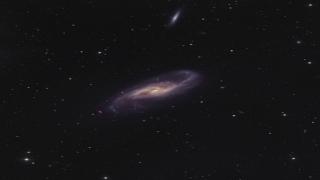Bibcode
Wilson, C. D.; Warren, B. E.; Israel, F. P.; Serjeant, S.; Bendo, G.; Brinks, E.; Clements, D.; Courteau, S.; Irwin, J.; Knapen, J. H.; Leech, J.; Matthews, H. E.; Mühle, S.; Mortier, A. M. J.; Petitpas, G.; Sinukoff, E.; Spekkens, K.; Tan, B. K.; Tilanus, R. P. J.; Usero, A.; van der Werf, P.; Wiegert, T.; Zhu, M.
Referencia bibliográfica
The Astrophysical Journal, Volume 693, Issue 2, pp. 1736-1748 (2009).
Fecha de publicación:
3
2009
Revista
Número de citas
101
Número de citas referidas
89
Descripción
We present large-area maps of the CO J = 3-2 emission obtained at the
James Clerk Maxwell Telescope for four spiral galaxies in the Virgo
Cluster. We combine these data with published CO J = 1-0, 24 μm, and
Hα images to measure the CO line ratios, molecular gas masses, and
instantaneous gas depletion times. For three galaxies in our sample (NGC
4254, NGC 4321, and NGC 4569), we obtain molecular gas masses of 7
× 108 - 3 × 109 M sun and
disk-averaged instantaneous gas depletion times of 1.1-1.7 Gyr. We argue
that the CO J = 3-2 line is a better tracer of the dense star-forming
molecular gas than the CO J = 1-0 line, as it shows a better correlation
with the star formation rate surface density both within and between
galaxies. NGC 4254 appears to have a larger star formation efficiency
(smaller gas depletion time), perhaps because it is on its first passage
through the Virgo Cluster. NGC 4569 shows a large-scale gradient in the
gas properties traced by the CO J = 3-2/J = 1-0 line ratio, which
suggests that its interaction with the intracluster medium is affecting
the dense star-forming portion of the interstellar medium directly. The
fourth galaxy in our sample, NGC 4579, has weak CO J = 3-2 emission
despite having bright 24 μm emission; however, much of the central
luminosity in this galaxy may be due to the presence of a central active
galactic nucleus.
Proyectos relacionados

Las Galaxias Espirales: Evolución y Consecuencias
Nuestro grupo pequeño esta bien conocido y respetado internacionalmente por nuestro trabajo inovativo e importante en varios aspectos de la estructura y la evolución de las galaxias espirales cercanas. Usamos principalmente observaciones en varias longitudes de onda, explotando las sinergías que nos permiten responder a las cuestiones más
Johan Hendrik
Knapen Koelstra